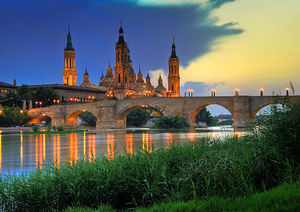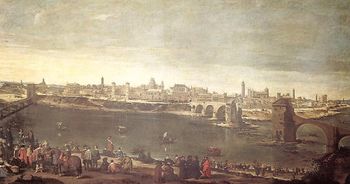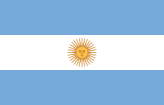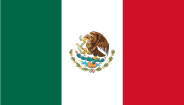Zaragoza
| Zaragoza | |||
|---|---|---|---|
 |
|||
|
|||
 Zaragoza
|
|||
| Coordinates: | |||
| Country | Spain | ||
| Autonomous community | Aragón | ||
| Province | Zaragoza | ||
| Comarca | Zaragoza | ||
| Districts | Casco Antinguo, Centro, Delicias, Universidad, San José, Las Fuentes, La Almozara, Oliver-Valdefierro, Torrero-La Paz, Margen Izquierda, Barrios Rurales Norte, Barrios Rurales Oeste | ||
| Government | |||
| - Type | Mayor-council | ||
| - Body | Ayunatmiento de Zaragoza | ||
| - Mayor | Juan Alberto Belloch (PSOE) | ||
| Area | |||
| - Total | 1,062.64 km2 (410.3 sq mi) | ||
| Elevation | 199 m (653 ft) | ||
| Population (1 January 2010)INE | |||
| - Total | 699,755 | ||
| - Density | 658.5/km2 (1,705.5/sq mi) | ||
| Demonym | zaragozano (m), zaragozana (f) | ||
| Time zone | CET (GMT +1) | ||
| - Summer (DST) | CEST (GMT +2) (UTC) | ||
| Postcode | 50001 - 50018 | ||
| ISO 3166-2 | ES-Z | ||
| Website | http://www.zaragoza.es/ | ||
Zaragoza (Spanish pronunciation: [θaɾaˈɣoθa]), also called Saragossa in English, is the capital city of the Zaragoza province and of the autonomous community of Aragon, Spain. It is situated on the river Ebro and its tributaries, the Huerva and Gállego, near the centre of the region, in a valley with a variety of landscapes, ranging from desert (Los Monegros) to thick forest, meadows and mountains.
The population of the city of Zaragoza in 1 January 2010 was 699,755,[1] ranking fifth in Spain. The population of the metropolitan area was estimated in 2006 at 783,763 inhabitants. The municipality is home to more than 50 percent of the Aragonese population. The city lies at an altitude of 199 metres above sea level, and constitutes a crossroads between Madrid, Barcelona, Valencia, Bilbao and Toulouse (France) — all of which are located about 300 kilometres (200 miles) from Zaragoza.
Zaragoza hosted Expo 2008 in the summer of 2008, a World's Fair on water and sustainable development. It will host another fair in 2014, the upcoming "Flowers Expo", and it is a candidate to be European Capital of Culture in 2016. Zaragoza wants to be a candidate city for the Winter Olympic Games 2022, the project is similar to Torino 2006 and Vancouver 2010. Ice and snow sports in Zaragoza, are popular in the nearby Pyrenees, where many of Spain's best ski resorts are located.
The city is famous for its folklore, a renowned local gastronomy, its trilogy of landmarks (the Basílica del Pilar, La Seo Cathedral and the The Aljafería Palace). Together with La Seo and the Aljaferia, several other buildings form part of the Mudéjar Architecture of Aragon which is a UNESCO World Heritage Site. The Fiestas del Pilar are among the most celebrated festivals in Spain.
Contents |
History
Early history

Sedetans, a tribe of Iberians, populated a village called Salduie, Salduba in Roman sources. Later on, Augustus founded there a city called Caesaraugusta to settle army veterans from the Cantabrian wars. The foundation date of Caesaraugusta has not been set with total precision though is known to lie between 25 BC and 12 BC. As an important feature, the city did not suffer any decline during the last centuries of the Roman empire and was captured by the Goths in the 5th century in a pacific way.
Arab Saraqusta

In 714 The Arabs took control of the city, renaming it Saraqusta (سرقسطة). It later became part of the Emirate of Cordoba, It grew to become the biggest Arab controlled city of Northern Spain. In 777 Charlemagne attempted to take the city but he was forced to withdraw when faced by the organized defense of the city and the Basque attacks in the rear (Chanson de Roland).
Taifa of Zaragoza
From 1018 to 1118 Zaragoza was one of the taifa kingdoms, independent Muslim states which emerged in the eleventh century following the destruction of the Cordoban Caliphate. During the first three decades of this period, 1018–1038, the city was ruled by the Banu Tujibi. In 1038 they were replaced by the Banu Hud, who had to deal with a complicated alliance with El Cid of Valencia and his Castilian masters against the Almoravids, who managed to bring the Taifas Emirates under their control. After the death of El Cid his kingdom was overrun by the Almoravids, who, by 1100, had managed to cross the Ebro into Barbastro, which brought Aragon into direct contact with them. The Banu Hud stubbornly resisted the Almoravids and ruled until they were eventually defeated by them in May 1110.

The last sultan of the Banu Hud, Abd-al-Malik Imad ad-Dawla, the last king of Zaragoza, forced to abandon his capital, allied himself with the Christian Aragonese under Alfonso the Battler and from that time the Muslims of Zaragoza became military regulars within the Aragonese forces.
Aragonese era
In 1118 the Aragonese conquered the city from the Almoravids and made it the capital of the Kingdom of Aragon. After Alfonso's death without heirs in 1134, Zaragoza was swiftly occupied by Alfonso VII of León and Castile, who vacated it in 1137 only on condition it be held by Ramon Berenguer IV of Barcelona as a fief of Castile.

Zaragoza was the scene of two controversial martyrdoms related with the Spanish Inquisition: those of Saint Dominguito del Val, a choirboy in the basilica, and Pedro de Arbués, head official of the inquisition. While the reality of the existence of Saint Dominguito del Val is questioned, his "murder" at the hands of "jealous Jews" was used as an excuse to murder or convert the Jewish population of Zaragoza.
Zaragoza suffered two famous sieges during the Peninsular War against Napoleonic army: a first from June to August 1808; and a second from December 1808 to February 1809 (see Agustina de Aragón, Siege of Saragossa (1809)), surrendering only after some 50,000 defenders had died.[2]
Modern history
Despite a decline in the outlying rural economy, Zaragoza has continued to grow. During the second half of the 20th century, its population boomed as a number of factories opened in the region.
In 1979 the Hotel Corona de Aragón fire killed at least 80. ETA has been blamed, but officially the fire is still regarded as accidental.
Demographics
Population growth, in thousands, can be seen here: 
- Historical Series of population: National Statistics Institute of Spain (INE)
- Dates 2006 City council of Zaragoza.
Climate
Zaragoza has a semi-arid climate (Köppen climate classification BSk), as it lies in a wide basin entirely surrounded by mountains, but shows characteristics of a Continental Mediterranean climate (Köppen: Dsa) such as drier summers and winters, and wetter springs and autumns. The average precipitation is a scanty 310 mm with abundant sunny days, and the rainfall centers in spring. There is drought in summer. The temperatures are high in summer reaching up to 40°C (104°F).
In winter the temperatures are low (usually 0 to 10°C) either because of the fog (about 20 days from November to January) or a cold and dry wind blowing from the NW, the Cierzo (related to other northerly winds such as the Mistral in the SE of France) on clear days. Frost is common and there is sporadic snowfall.
| Climate data for Zaragoza | |||||||||||||
|---|---|---|---|---|---|---|---|---|---|---|---|---|---|
| Month | Jan | Feb | Mar | Apr | May | Jun | Jul | Aug | Sep | Oct | Nov | Dec | Year |
| Source: World Weather Information Service[3] | |||||||||||||
Economy

In addition to the advantageous geographic situation, a General Motors Opel factory was opened in 1982 in Figueruelas, a small village nearby. The progressive decline of the agrarian economy turned Opel into one of the main pillars of the regional economy, along with: Balay, which manufactures household appliances; CAF (Construcciones y Auxiliar de Ferrocarriles S.A.), which builds railway engines for both the national and international markets; SAICA and Torraspapel in the stationery sector; and various other local companies, such as Pikolin and Lacasa, that are gradually making their ways into the international market.
The city's economy benefited from projects like the Expo 2008 (the official World's Fair, with the theme of water and sustainable development, held between 14 June and 14 September 2008), Plataforma Logística de Zaragoza (PLAZA), Parque Tecnológico de Reciclado (PTR), as well as being on the route of the AVE high-speed rail route since December 2003, which consolidates the city role as a communications hub. Currently, Zaragoza's Airport is a major cargo hub in the Iberian Peninsula, only behind Madrid, Barcelona and Lisbon.
Zaragoza is home to a Spanish Air Force base, which was (until 1994) shared with the U.S. Air Force.[4] In English, the base was known as Zaragoza Air Base. The Spanish Air Force maintained an F/A-18 Hornet wing at the base. No American flying wings (with the exception of a few KC-135's) were permanently based there, but it served as a training base for American fighter squadrons across Europe. It is also the main headquarters for the Spanish Land Army, hosting the Academia General Militar, a number of brigades at San Gregorio, and other garrisons.
Culture

Zaragoza is linked by legend to the beginnings of Christianity in Spain. According to legend, the Virgin Mary appeared miraculously to Saint James the Great in the first century, standing on a pillar. This legend is commemorated by a famous Catholic basilica called Nuestra Señora del Pilar ("Our Lady of the Pillar").
The event, called "Las Fiestas del Pilar", is celebrated on 12 October, which is a major festival day in Zaragoza. Since it coincided in 1492 with the discovery of the Americas by Christopher Columbus, that day is also celebrated as El Día de la Hispanidad (Columbus Day, literally Hispanic Day) by Spanish-speaking people worldwide.
"El Pilar" lasts for nine days, with all kinds of acts: from the massively attended Pregon (opening speech) to the final fireworks display over the Ebro, there are bands, dances, procession of gigantes y cabezudos (carnival figures made of papier mache), concerts, exhibitions, the famous "vaquillas" bulls and the bull festival. Some of the most important features are the Ofrenda de Flores (Flower offering) to the virgin on the 12th, when an enormous cloak is made of the flowers
Education
The University of Zaragoza is headquartered in the city. As one of the oldest universities of Spain and a major research and development center, this public university awards all the highest academic degrees in dozens of fields.
There is also a private university, Universidad San Jorge, which is located in Villanueva de Gállego, 14 km to the north.
Transportation
.jpg)
The city is connected by motorway with Madrid, Barcelona, Valencia, Bilbao and Toulouse — all of which are located about 300 kilometres (200 miles) from Zaragoza.
The Zaragoza Airport is a small commercial airport. It also is the home of the Spanish Air Force 15th Group, as well as being utilized by NASA as a contingency landing site for the Space Shuttle in the case of a Transoceanic Abort Landing (TAL).
Zaragoza is also connected to the Spanish High Speed railway (Renfe's AVE), by the Madrid-Barcelona high-speed rail line. Madrid is reachable in 1 hour 15 minutes, and Barcelona in approximately 1 hour 30 minutes. The central station is "Intermodal Zaragoza Delicias Station" where they operate railway lines and buses. In addition to long distance railway lines or high speed railway, Zaragoza has a network of cercanías.
The city has a network of buses which is controlled by TUZSA. (Urban Transport Company of Zaragoza). The network consists of 28 regular lines, 4 line-up, 4 launchers, special line 1, 8 special lines on the occasion of Expo 2008 and 7 lines at night.
Sport
.jpg)
Zaragoza's football team, Real Zaragoza, plays in the Primera División. One of the most remarkable events in the team's recent history is the winning of the former UEFA Cup Winners' Cup in 1995. The team has also won the Spanish National Cup "Copa del Rey" six times: 1965, 1966, 1986, 1994, 2001 and 2004 and a Inter-Cities Fairs Cup (1964).
Zaragoza's handball team, CAI BM Aragón, plays in the Liga ASOBAL.
Their local basketball team, CAI ZARAGOZA, is now on the ACB league. They play at the Príncipe Felipe with a capacity of 11,000 and their head coach is Curro Segura.
Zaragoza was strongly associated with Jaca in its failed bid for the 2014 Winter Olympics.
A permanent feature built for Expo 2008 is the pump-powered artificial whitewater course "El Canal de Aguas Bravas."
Main sights

Near the basilica on the banks of the Ebro are located the city hall, the Lonja (old currency exchange), La Seo (literally "the See" in the Aragonese language) or Cathedral of San Salvador, a magnificent church built over the main mosque (partially preserved in the 11th-century north wall of the Parroquieta), with Romanesque apses from 12th century; inside, the imposing hallenkirche from the 15th to 16th centuries, the Baroque tower, and finally, with its famous Museum of Tapestries near the Roman ruins of forum and port city wall.
Some distance from the centre of the old city is the Moorish castle (or palace) Aljafería, the most important Moorish buildings in northern Spain and the setting for Giuseppe Verdi's opera Il trovatore (The Troubadour). The Aragonese parliament currently sits in the building.
The churches of San Pablo, Santa María Magdalena and San Gil Abad were built in 14th century, but the towers may be old minarets dating from the 11th century; San Miguel (14th century); Santiago (San Ildefonso) and the Fecetas monastery are Baroque with Mudéjar ceilings of the 17th century. All the churches are Mudéjar monuments that comprise a World Heritage Site

Other important sights are the stately houses and magnificent palaces in the city, mainly of the 16th century: palaces of the count of Morata or Luna (Audiencia), Deán, Torrero (colegio de Arquitectos), Don Lope or Real Maestranza, count of Sástago, count of Argillo (today the Pablo Gargallo museum), archbishop, etc.
The most important Zaragoza museums are the Museum of Fine Arts, with paintings by early Aragonese artists, 15th century, and by El Greco, Ribera and Goya, and the Camon Aznar Museum, with paintings ranging from Rubens, Rembrandt, Van Dyck, Velazquez and Goya to Renoir, Manet and Sorolla.
On 14 June 2008, the site of Expo 2008 opened its doors to the public. The exhibition ran until 14 September.
Other sights

- Puente de Piedra
- San Idelfonso church
- Santa Engracia Monastery
- San Nicolás de Bari church
- Santo Tomás de Aquino church
- San Agustín Convent
- Church of Santa Isabel de Portugal
- Casa Solans
- Palacio de los Luna
- Arch of Deán
- Arguillo Palace
- Casino mercantil
- Bullring
- The Giants of Zaragoza
- Primo de Rivera Park
Twin towns - sister cities
The following are Sister cities of Zaragoza:[5]
 Pau, France
Pau, France Skopje, Macedonia[6]
Skopje, Macedonia[6] Biarritz, France
Biarritz, France Móstoles, Spain
Móstoles, Spain Bethlehem, Palestinian Authority[7][8][9]
Bethlehem, Palestinian Authority[7][8][9] León, Nicaragua
León, Nicaragua La Plata, Argentina
La Plata, Argentina Zaragoza, Guatemala
Zaragoza, Guatemala Tijuana, Mexico
Tijuana, Mexico Ponce, Puerto Rico
Ponce, Puerto Rico Coimbra, Portugal[10]
Coimbra, Portugal[10] Zamboanga City, Philippines
Zamboanga City, Philippines Kyoto, Japan
Kyoto, Japan Tirana, Albania[11][12]
Tirana, Albania[11][12] La Paz, Bolivia
La Paz, Bolivia Cúcuta, Colombia
Cúcuta, Colombia Toulouse, France
Toulouse, France Barnaul, Russia
Barnaul, Russia Dalian, China
Dalian, China Yulin, China
Yulin, China Mdina, Malta
Mdina, Malta Córdoba, Argentina
Córdoba, Argentina
See also
- Roman Catholic Archdiocese of Zaragoza
- Zaragoza Airport
- Expo 2008
- Crown of Aragon
References
- Notes
- ↑ [1]
- ↑ "Napoleon's Total War"
- ↑ "Weather Information for Zaragoza". World Weather Information Service. http://www.worldweather.org/083/c01240.htm. Retrieved 1 January 2009.
- ↑ John Pike. "Zaragoza Air Base". Globalsecurity.org. http://www.globalsecurity.org/military/facility/zaragoza.htm. Retrieved 2009-06-25.
- ↑ Cities twinned with Zaragoza. Zaragoza City Hall
- ↑ "Official portal of City of Skopje - Skopje Sister Cities". © 2006-2009 City of Skopje. http://www.skopje.gov.mk/EN/DesktopDefault.aspx?tabindex=0&tabid=69. Retrieved 2009-07-14.
- ↑ "::Bethlehem Municipality::". www.bethlehem-city.org. http://www.bethlehem-city.org/Twining.php. Retrieved 2009-10-10.
- ↑ "Twinning with Palestine". © 1998-2008 The Britain - Palestine Twinning Network. http://www.twinningwithpalestine.net/groupsinternational.html. Retrieved 2008-11-29.
- ↑ The City of Bethlehem has signed a twinning agreements with the following cities Bethlehem Municipality.
- ↑ "Acordos de Geminação" (in Portuguese). © 2009 Câmara Municipal de Coimbra - Praça 8 de Maio - 3000-300 Coimbra. http://www.cm-coimbra.pt/index.php?option=com_content&task=view&id=62&Itemid=128. Retrieved 2009-06-25.
- ↑ "Twinning Cities: International Relations" (PDF). Municipality of Tirana. www.tirana.gov.al. http://www.tirana.gov.al/common/images/International%20Relations.pdf. Retrieved 2009-06-23.
- ↑ Twinning Cities: International Relations. Municipality of Tirana. www.tirana.gov.al. Retrieved on 2008-01-25.
External links
- Zaragoza travel guide from Wikitravel
- Council of Zaragoza
- Saragossa Global (English)
- Saragossa Brand (English)
- Zaragoza Tourism Board Official Website
- Overview of the City
- Complete guide to Zaragoza

